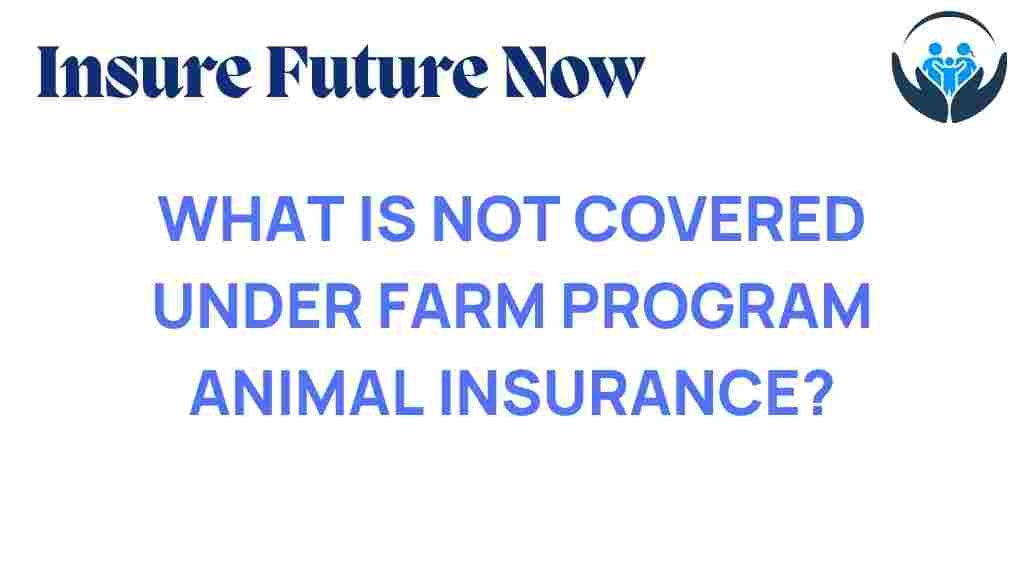Uncovering the Gaps: What Farm Program Animal Insurance Doesn’t Cover
Farm program animal insurance is a crucial component of risk management for livestock producers. It provides a safety net against unforeseen events that can impact farming operations. However, many farmers may not fully understand the coverage gaps associated with their policies. This article aims to shed light on these gaps, helping farmers make informed decisions about their insurance policies and financial planning.
Understanding Farm Program Animal Insurance
Farm program animal insurance is designed to protect livestock against various risks, including disease, accidents, and natural disasters. While it can provide substantial protection, it is vital for farmers to be aware of the limitations and exclusions that may exist within their policies. Understanding these coverage gaps is essential for effective risk management.
Common Coverage Gaps in Farm Program Animal Insurance
Despite the importance of animal insurance in safeguarding livestock, several gaps often go unnoticed by farmers. Here are some of the most common coverage gaps:
- Policy Limits: Many policies have caps on the amount they will pay out per animal or per incident. This can leave farmers vulnerable if the losses exceed these limits.
- Exclusions for Pre-existing Conditions: Livestock with known health issues may not be covered under some policies, which can be a significant concern for farmers with older animals.
- Natural Disasters: While some policies cover certain natural disasters, many do not include coverage for all types of events, such as floods or earthquakes.
- Market Fluctuations: Insurance often does not account for changes in market prices, which can affect the financial viability of livestock sales.
- Theft and Vandalism: Not all policies cover losses due to theft or vandalism, which can be a significant risk for farmers.
How to Identify Coverage Gaps in Your Policy
Identifying the coverage gaps in your farm program animal insurance requires careful review of your insurance policy. Here’s a step-by-step process to help you uncover any potential issues:
- Review Your Policy Documents: Start by carefully reading your insurance policy documents. Look for sections that outline coverage limits, exclusions, and specific conditions.
- Consult Your Insurance Agent: Schedule a meeting with your insurance agent to discuss your policy. They can help clarify any confusing terms and highlight areas where coverage may be lacking.
- Compare Policies: Research other insurance options available in the market. Comparing different policies can provide insights into standard coverage and help identify gaps in your current plan.
- Assess Your Farming Risks: Evaluate the specific risks associated with your farming operations. Consider factors like location, climate, and livestock types to determine what additional coverage you may need.
- Keep Records: Maintain detailed records of livestock health, incidents, and any previous claims. This information can be useful in discussions with your insurance provider.
Financial Planning and Risk Management Strategies
Effective financial planning and risk management are essential for farmers to protect their investments and ensure the sustainability of their operations. Here are some strategies to consider:
- Diversify Livestock: Diversifying the types of livestock you raise can reduce the impact of losses in any single category.
- Emergency Funds: Establish an emergency fund to cover unexpected losses that may not be fully covered by insurance.
- Regular Policy Reviews: Conduct regular reviews of your insurance policies to ensure they align with changes in your farming operations and risks.
- Education and Training: Invest in education and training for you and your staff to mitigate risks associated with livestock health and safety.
- Utilize Resources: Use resources from agricultural extension services, farming cooperatives, and online platforms to stay informed about best practices in risk management.
Troubleshooting Common Issues with Farm Program Animal Insurance
Farmers may encounter various issues with their animal insurance policies. Here are some troubleshooting tips to address common problems:
- Claim Denials: If your claim is denied, carefully review the reasons provided. Contact your insurance agent to discuss the denial and see if additional documentation can support your claim.
- Inadequate Coverage: If you find that your coverage is insufficient, consider increasing your policy limits or adding supplemental coverage for risks that are not currently covered.
- Policy Confusion: If you are confused about any aspect of your policy, do not hesitate to ask your insurance agent for clarification. Clear communication is key to understanding your coverage.
- Changing Needs: As your farming business evolves, so too will your insurance needs. Be proactive in adjusting your coverage to match your current situation.
Conclusion
Understanding the gaps in farm program animal insurance is critical for effective risk management and financial planning. By identifying coverage limitations, engaging with your insurance provider, and implementing strategic risk management practices, you can better protect your livestock and your investment. Remember, staying informed and proactive is the best way to navigate the complexities of animal insurance.
For more information on managing farming risks and understanding animal insurance, consider visiting this resource or consult your local agricultural extension office. By taking these steps, you can ensure that you are well-prepared to face the various challenges that come with livestock farming.
In conclusion, while farm program animal insurance is essential, it is equally important to recognize its limitations. Awareness of coverage gaps, policy limits, and potential exclusions will empower you to make informed decisions that safeguard your livestock and enhance the sustainability of your farming operations.
This article is in the category Coverage and created by InsureFutureNow Team
